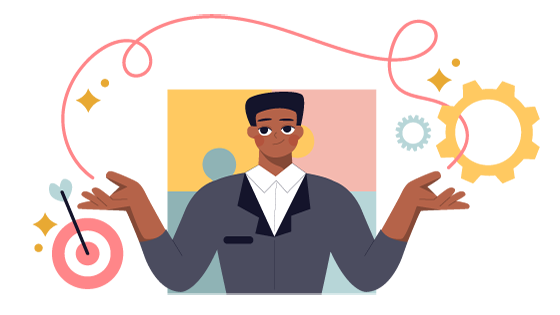Even if you aren’t familiar with the term “hero’s journey,” you’ll recognize the premise. It’s the classic storyline pattern from all of your favorite childhood fairytales: Hero is introduced; hero encounters trials; hero rises triumphant. Professor of Literature and mythologist Joseph Campbell was the first to formally identify the archetypal protagonist’s pattern in his 1949 book, The Hero with a Thousand Faces.
It might sound familiar for your favorite novel or the last movie you saw, but what does this mean for your training materials? The good news is that you don’t need an Academy Award-winning director to create meaningful and successful training. Instead, you can adopt the key steps from the hero’s journey and blend them with well-known training models to create a story that is as engaging as it is effective.
The hero’s journey storyline immediately resonates with your learners because it makes them the hero of their own story: first, learners see themselves in the protagonist role; then, they get to work on the pathway to triumph. This journey elicits an Angel’s Cocktail of chemicals in your learner’s brains—dopamine, oxytocin, and endorphins—making the learning more meaningful and engaging.
What is the Role of Storytelling in Training?
We talk about storytelling for training a lot. In fact, we wrote a whole ebook about it. That’s because if you were only going to use one element for your training, we’d choose storytelling every time. Think about it: Humans have used storytelling as a way to warn, educate, and inspire since, well, humans were around. Even cave paintings are a form of ancient storytelling that passed down useful information from generation to generation.
Storytelling is so effective because it “tricks” the brain into absorbing new information by decreasing its cognitive load and increasing retention. When you hear a story with characters, a plot, and a satisfying conclusion, it’s easier to remember and more impactful than if someone were to simply tell you the facts.
Why Use Storytelling In Corporate Training?
Facts and figures are important, but they’re rarely inspiring. When you use storytelling in corporate training, you reap the following big benefits:
Creating Connection
Storytelling has a way of making information both relatable and contextual: two factors in impactful learning. Learners see themselves as the protagonist in a story and can see how new information, procedures, or skills will directly affect their day-to-day. By presenting info via story, you create a strong emotional bond that makes learning sticky.
Simplifying Complex Topics
We get it: Some of the training you need to cover can be complex, long, and technical. It might not seem like storytelling is automatically the best fit for exhaustive information. But we believe that storytelling is actually the best delivery method for complex topics, whether it’s in-depth product information or something as vital as sexual harassment training. Storytelling allows learners to experience new information in a safe way while presenting complicated, abstract topics in real and relatable scenarios.
More Memorable
According to research done by psychologist Jerome Bruner, learners are 20 times more likely to remember facts when they’re presented as part of a story. Stories work to ignite as many senses and emotions as possible. When learners see and feel, they’re more likely to convert information to long-term memory.
Influence Behavior
The end-goal of any learning experience should be a meaningful and measurable change in behavior. Facts simply won’t have the long-term effects on behavior that storytelling will. That’s because storytelling allows learners to experience a variety of situations and scenarios to see how different decisions affect outcomes. Through the story, they naturally uncover what values and behaviors are more important to them and can apply them in a risk-free environment.
Key Elements Of Storytelling Learning In Corporate Training
If storytelling sounds like the right delivery method for your training, you’re probably already brainstorming compelling characters and relatable narratives. Before you start telling your story, however, consider these key elements for corporate training.
Audience Analysis
Before you start building your training, you need to create a road map for your audience. Who is your hero? Where is he or she going? What do you want them to feel? Learn? Take the time to understand your learners before committing to the storyline. After all, every hero needs a map.
A Compelling Narrative
It’s important that your learners see themselves as the hero of the story. Creating a compelling narrative begins by putting yourself in your learners’ shoes and deciding what types of stories and scenarios will connect most with their roles. Whether it’s a specific pain point or a character that has similar duties, you’ll get learners to feel more connected if you build a world with recognizable scenes and relatable situations.
Creative Instructional Design
Think of your favorite book when you were a child. What were some of the elements you loved the most? Chances are that the design was every bit as eye-catching as the story, with bright pictures and dynamic characters. It’s the same principle with storytelling for corporate training: Design matters just as much as the tale you tell.
Think about building inclusive characters that learners can use as relatable avatars. Direct focus to important factors using changes in font. Use color theory to elicit a certain emotion from your learners. Creative instructional design goes hand-in-hand with storytelling to deliver a more holistic experience for your heroes.
Case Study: Lord of the Rings as Learning Theory
The best way to teach is to show instead of tell. Frodo Baggins in The Lord of the Rings is a classic example of a well-known, relatable hero. Throughout the first book (or movie, if you didn’t make it through J.R.R. Tolkien’s epic saga), Frodo goes through every step of the hero’s journey formula. Here’s a breakdown of how the hero’s journey works in The Lord of the Rings and how, with the addition of the ADKAR model, it can work for your training.
We recently worked with the sales department of a well-known social media powerhouse who wanted their new salespeople to succeed in their roles. First, we talked to the sales team and mapped out our audience. Then, we utilized the ADKAR model to outline exactly what was needed to change their existing habits and behavior.
We created a hero’s journey-based onboarding that made each team member the protagonist in their very own Fellowship of the Ring story.
How Can the Hero’s Journey Be Used in Corporate Training?
Analyzing The Lord of the Rings this way makes it clear that Frodo’s journey, while engaging and exciting, was really just a fantastical version of the ADKAR model.
Through his story, he was aware of his quest; he had a desire to complete it; he was given the knowledge and ability; and eventually, the reinforcement he needed to return triumphant. And chances are that if you’re a Lord of the Rings fan, you were glued the entire way.



The Reason Strategic Storytelling Works
Now that you know about the hero’s journey, you will start to see it everywhere. It’s the plot line of some of the most popular movies, from Star Wars to The Lion King — because it’s one of the most common and relatable plot arcs.
Instructional storytelling is just like that: A good story may seem simple, but it’s actually a complicated marriage of neurotransmitters, attention, and behavioral change.
Incorporating stories into your training allows your learners to experience, remember, and then act, resulting in a meaningful, memorable experience. Once you stop thinking about training as a checklist and more as a story, your learners’ own journeys can begin.
Ready to tell your own training story? Contact us today to get started on your project.






